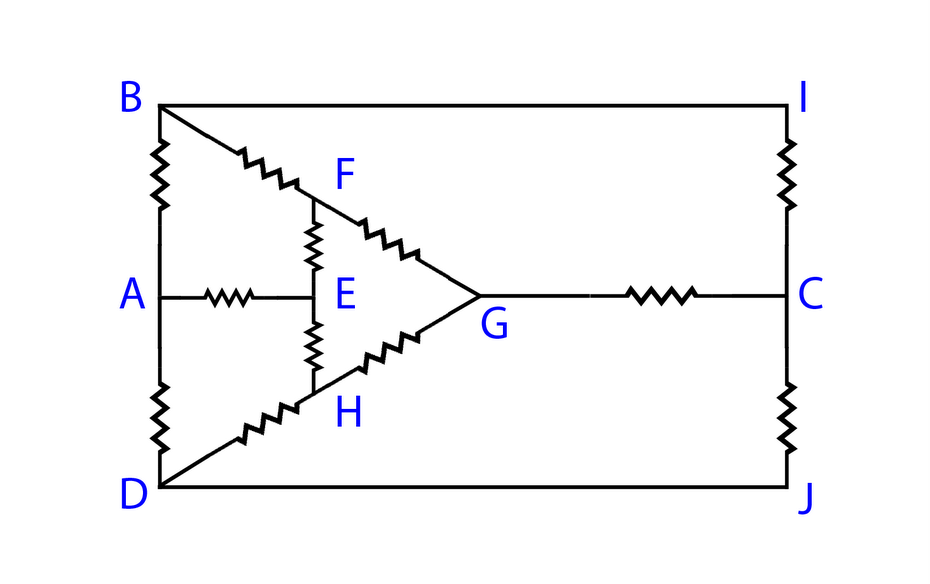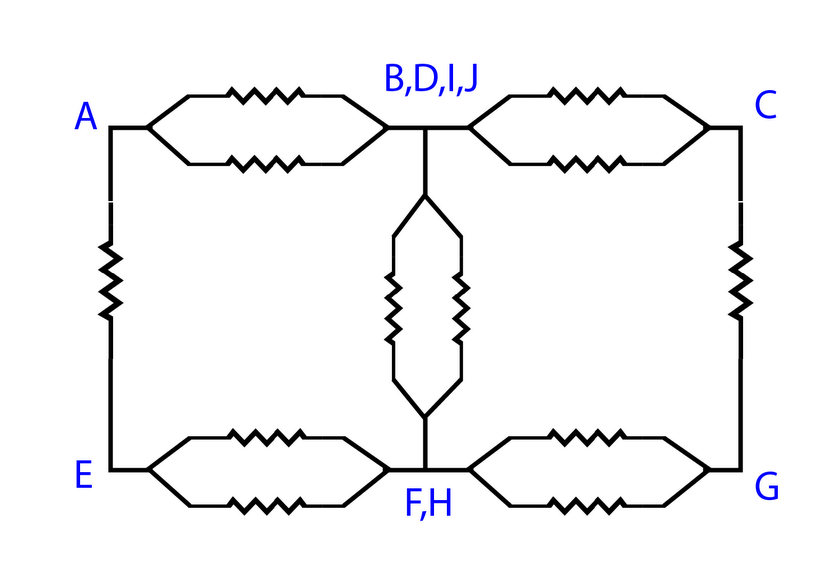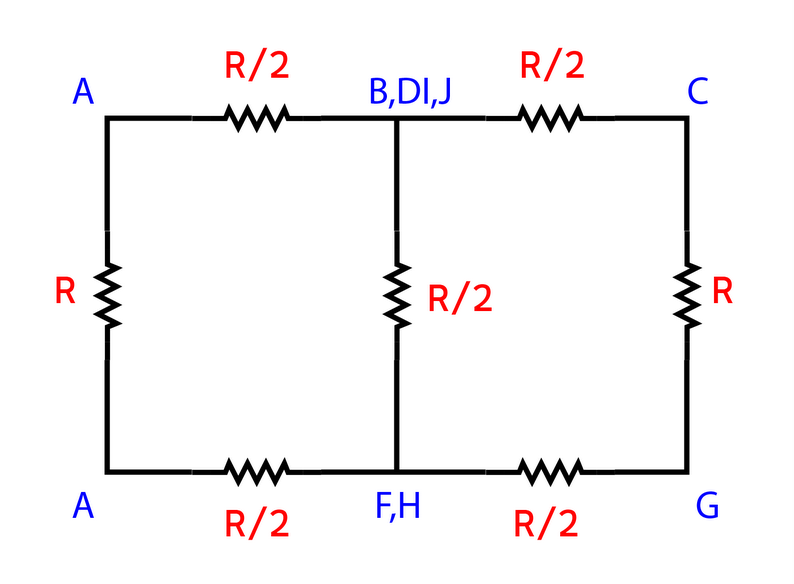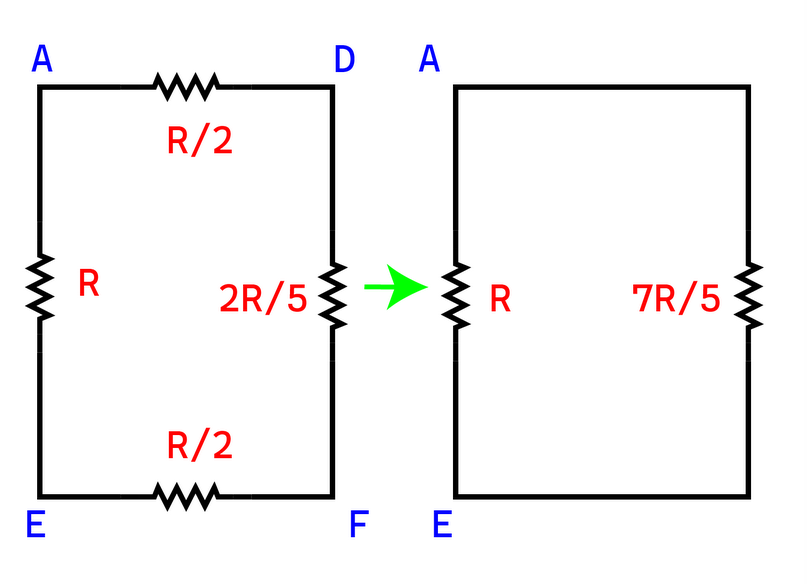
Find the equivalent resistance between A and B (resistance of each resistor is R).

A) $\dfrac{7}{{12}}R$
B) $\dfrac{7}{{13}}R$
C) $\dfrac{7}{{15}}R$
D) $\dfrac{8}{{13}}R$
Answer
218.4k+ views
Hint:The problem is from the electricity part of physics. We can apply the concept of parallel combination and series combination of resistance here. Use the equation for effective resistance in parallel and series combinations.
Formula Used:
Equivalent resistance for a series resistance circuit:
${R_E} = {R_1} + {R_2} + {R_3}$
Where ${R_E}$= equivalent resistance and ${R_1},{R_2},{R_3}$ = component resistance.
Equivalent resistance for a parallel resistance circuit:
$\dfrac{1}{{{R_E}}} = \dfrac{1}{{{R_1}}} + \dfrac{1}{{{R_2}}} + \dfrac{1}{{{R_3}}}$
Where ${R_E}$= equivalent resistance and ${R_1},{R_2},{R_3}$ = component resistance.
Complete answer:
The equivalent resistance is a single resistance which can replace all the component resistances in a circuit in such a manner that the current in the circuit remains unchanged.
The circuit can be re-draw into a simple form.

Now we can find the equivalent resistance for the five parallel combinations.
\[\dfrac{1}{{{R_E}}} = \dfrac{1}{R} + \dfrac{1}{R} = \dfrac{2}{R} \Rightarrow {R_E} = \dfrac{R}{2}\]
The circuit diagram will become.

Three resistances in the right side are in series combination. Their equivalent resistance will become.
\[{R_E} = \dfrac{R}{2} + R + \dfrac{R}{2} = 2R\]
This equivalence resistance is in parallel with \[\dfrac{R}{2}\] on the right side.
\[\frac{1}{{{R_E}}} = \frac{1}{{2R}} + \frac{1}{\frac{R}{2}} = \frac{1}{{2R}} + \frac{2}{R} = \frac{5}{{2R}} \Rightarrow {R_E} = \frac{{2R}}{5}\]

The three series combination resistance will be
\[{R_E} = \dfrac{R}{2} + \dfrac{R}{2} + \dfrac{{2R}}{5} = \dfrac{{7R}}{5}\]
The final parallel combination is solved by
\[\dfrac{1}{{{R_E}}} = \dfrac{1}{R} + \dfrac{1}{{\left( {\dfrac{{7R}}{5}} \right)}} = \dfrac{1}{R} + \dfrac{5}{{7R}} = \dfrac{{12}}{{7R}} \Rightarrow {R_E} = \dfrac{{7R}}{{12}}\]
Hence, the correct option is Option (A).
Note: Resistance is a measure of the opposition to current flow in an electrical circuit. Resistance blocks the flow of current. The S.I unit of resistance is ohms. The current decreases as resistance increases. On the other hand, the current increases as the resistance decreases. While solving this question pay close attention to circuits and terminals in which these resistances are connected and apply the concepts of parallel combination and series combination of resistance accordingly.
Formula Used:
Equivalent resistance for a series resistance circuit:
${R_E} = {R_1} + {R_2} + {R_3}$
Where ${R_E}$= equivalent resistance and ${R_1},{R_2},{R_3}$ = component resistance.
Equivalent resistance for a parallel resistance circuit:
$\dfrac{1}{{{R_E}}} = \dfrac{1}{{{R_1}}} + \dfrac{1}{{{R_2}}} + \dfrac{1}{{{R_3}}}$
Where ${R_E}$= equivalent resistance and ${R_1},{R_2},{R_3}$ = component resistance.
Complete answer:
The equivalent resistance is a single resistance which can replace all the component resistances in a circuit in such a manner that the current in the circuit remains unchanged.
The circuit can be re-draw into a simple form.

Now we can find the equivalent resistance for the five parallel combinations.
\[\dfrac{1}{{{R_E}}} = \dfrac{1}{R} + \dfrac{1}{R} = \dfrac{2}{R} \Rightarrow {R_E} = \dfrac{R}{2}\]
The circuit diagram will become.

Three resistances in the right side are in series combination. Their equivalent resistance will become.
\[{R_E} = \dfrac{R}{2} + R + \dfrac{R}{2} = 2R\]
This equivalence resistance is in parallel with \[\dfrac{R}{2}\] on the right side.
\[\frac{1}{{{R_E}}} = \frac{1}{{2R}} + \frac{1}{\frac{R}{2}} = \frac{1}{{2R}} + \frac{2}{R} = \frac{5}{{2R}} \Rightarrow {R_E} = \frac{{2R}}{5}\]

The three series combination resistance will be
\[{R_E} = \dfrac{R}{2} + \dfrac{R}{2} + \dfrac{{2R}}{5} = \dfrac{{7R}}{5}\]
The final parallel combination is solved by
\[\dfrac{1}{{{R_E}}} = \dfrac{1}{R} + \dfrac{1}{{\left( {\dfrac{{7R}}{5}} \right)}} = \dfrac{1}{R} + \dfrac{5}{{7R}} = \dfrac{{12}}{{7R}} \Rightarrow {R_E} = \dfrac{{7R}}{{12}}\]
Hence, the correct option is Option (A).
Note: Resistance is a measure of the opposition to current flow in an electrical circuit. Resistance blocks the flow of current. The S.I unit of resistance is ohms. The current decreases as resistance increases. On the other hand, the current increases as the resistance decreases. While solving this question pay close attention to circuits and terminals in which these resistances are connected and apply the concepts of parallel combination and series combination of resistance accordingly.
Recently Updated Pages
A square frame of side 10 cm and a long straight wire class 12 physics JEE_Main

The work done in slowly moving an electron of charge class 12 physics JEE_Main

Two identical charged spheres suspended from a common class 12 physics JEE_Main

According to Bohrs theory the timeaveraged magnetic class 12 physics JEE_Main

ill in the blanks Pure tungsten has A Low resistivity class 12 physics JEE_Main

The value of the resistor RS needed in the DC voltage class 12 physics JEE_Main

Trending doubts
JEE Main 2026: Application Form Open, Exam Dates, Syllabus, Eligibility & Question Papers

Derivation of Equation of Trajectory Explained for Students

Hybridisation in Chemistry – Concept, Types & Applications

Understanding the Angle of Deviation in a Prism

Understanding Collisions: Types and Examples for Students

Understanding Atomic Structure for Beginners

Other Pages
JEE Advanced Marks vs Ranks 2025: Understanding Category-wise Qualifying Marks and Previous Year Cut-offs

How to Convert a Galvanometer into an Ammeter or Voltmeter

Understanding Centrifugal Force in Physics

Ideal and Non-Ideal Solutions Explained for Class 12 Chemistry

Degree of Dissociation: Meaning, Formula, Calculation & Uses

Understanding Electromagnetic Waves and Their Importance




